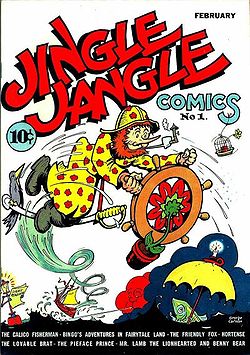Jingle Jangle Comics
| Jingle Jangle Comics | |
|---|---|
 First issue cover, February 1942 | |
| Publication information | |
| Publisher | Eastern Color under the Famous Funnies, Inc. imprint |
| Schedule | Bimonthly |
| Format | Color; Newsprint |
| Publication date | February 1942 – December 1949 |
| No. of issues | 42 |
| Creative team | |
| Created by | Steven Douglas (editor) George L. Carlson (principal artist) |
Jingle Jangle Comics was a ten-cent, bimonthly, 42-issue, 68-page (later reduced to 52-page) children's-oriented American comic book magazine published by Eastern Color under the Famous Funnies, Inc. imprint between February 1942 and December 1949.[1] The series featured mixes of human and cartoon animal material. The series was edited by Steven Douglas with George L. Carlson as principal artist. Additional stories were drawn by David Tendlar.[1]
George Carlson[]
George L. Carlson was in his mid-fifties and a veteran children's book illustrator and puzzle maker when he took on Jingle Jangle Comics. His experience included painting the first edition dust jacket for Margaret Mitchell's Gone with the Wind and ghosting the newspaper strip Reg’lar Fellas for artist Gene Byrnes. He had previously published Jingle Jangle Tales as a children's book and an unsuccessful Sunday newspaper page. Each issue of the comic book contained at least one of his two features (and many contained both): "Jingle Jangle Tales" and "The Pie-Face Prince of Pretzelburg".[2] Carlson completed every aspect of his features himself – pencils, inks, etc. – earning $25 per page for the twelve pages he produced for each issue.
His stories included "The Youthful Yodeler and the Zig-Zag Zither", "The Fashionable Fireman and the Soft-Boiled Collar Button" and "The Extra Salty Sailor and the Flat-Footed Dragon."[1]
Analysis[]
Carlson's sophisticated Jingle Jangle fairy tales mixed burlesque, fantasy, and wordplay with his own brand of nonsense in multi-layered features of visual and verbal harmony. Characters in his work included the Youthful Yodeler, the Half-Champion Archer, the Very Horseless Jockey, King Hokum of Pretzleburg and his son the pie-face Prince Dimwitri, the Princess Panetella Murphy (Dimwitri's love), the Raging Raja (Dimwitri's favorite enemy), and the Wicked Green Witch. Dimwitri's adventures were many and varied: in one tale, he went aloft in an 18-carat balloon in search of a missing bass drum and in another he searched for the Doopsniggle Prize with his corned-beef flavored cabbage plant.
Reception[]
Noted critic and science-fiction writer Harlan Ellison penned an ode to Carlson and Jingle Jangle in an essay called "Comic of the Absurd", published in the 1970 collection All in Color for a Dime. Ellison wrote,
"Who is George Carlson? I'm glad you asked. It's about time someone did. George Carlson is Samuel Beckett in a clever plastic disguise. He is Harold Pinter scrubbed clean of the adolescent fear and obscurity, decked out in popcorn balls and confetti. He is Genet without hangups. He is Pirandello buttered with dream-dust and wearing water wings. He is Santa Claus and Peter Pan and the Great Pumpkin and the Genie in the Jug and what Walt Disney started out to be and never quite made... [Carlson] was one of the first cartoonists of the absurd, and a) how he came to develop his style in a time when cuddly animals were the going thing, b) a publishing house like Famous Funnies that trafficked in cuddly animals employed him, and c) kids like myself who really couldn't have understood what he was about, dug him... are improbabilities too staggering to deal with."[3]
References[]
- ^ a b c Mitchell, Kurt; Thomas, Roy (2019). American Comic Book Chronicles: 1940-1944. TwoMorrows Publishing. p. 207, 264. ISBN 978-1605490892.
- ^ Markstein, Don. "The Pie-Face Prince of Pretzelburg". Don Markstein's Toonopedia. Retrieved 22 April 2020.
- ^ Ellison, Harlan (1997). "Comic of the Absurd". All in Color for a Dime. Krause Publications. pp. 241–242. ISBN 9780873414982.
Sources[]
- Goulart, Ron (2001). Great American Comic Books. Publications International Ltd. pp. 152–5.
- "Jingle Jangle Comics". Grand Comics Database. Retrieved March 25, 2010.
- Comics publications
- Comics magazines published in the United States
- 1942 comics debuts
- 1949 comics endings
- Fantasy comics
- Magazines established in 1942
- Magazines disestablished in 1949
- Golden Age comics titles
- Comics stubs